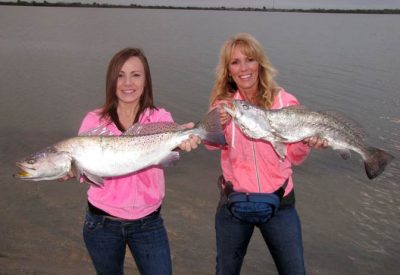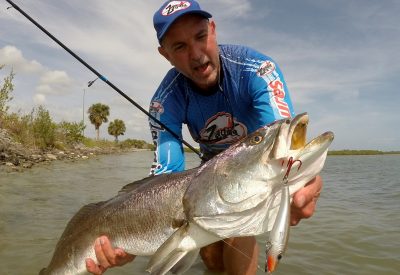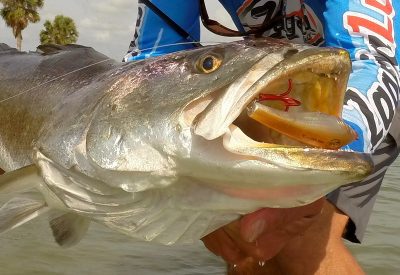By Paul MacInnis
In the spring a young man’s fancy turns to monster seatrout. I’m not so young but my fancy does turn to trophy trout. Truly large trout are never an easy fish to catch, but your odds are better in May and June when trout of all sizes feed more aggressively as they fatten up for the spawn.
Gator is a name often used for seatrout over six pounds. That is a fine fish indeed, but I apply the term monster to double digit fish that top ten pounds. I’ve been blessed to catch three monster trout in my life. The first came on a Rapala X-Rap Walk, a large walk-the-dog topwater plug that is no longer made. The second ate a Rapala Skitterwalk, another walk-the-dog topwater plug. The third, caught just this last April, fell to a Zagaia Prima Gold Stick, a shallow running Brazilian made lure with a nice seductive darting action.
Do you notice any trends? For starters, all three trout were caught on lures that imitate a meaty finger mullet. It may seem counter intuitive but more trophy seatrout are caught on artificial lures than bait. Big trout are loners and lures allow you to cover a lot of water, increasing your odds of intercepting bigger fish. About 80% of an adult seatrout’s diet is fish and most big old trout prefer a hearty, calorie rich meal. With that in mind, large, mullet imitating lures are a good choice. The one exception to the big lure theory is plastic shrimp. Few trout of any size will turn down a protein dense, easily digestible shrimp snack.
Another thing those three monster trout had in common was they were all caught on surface or shallow running lures. Most big trout are caught on shallow grass flats one and a half to three feet deep. Flats should have dense grass mixed with a few sandy potholes that trout can use to ambush prey. The area should also have a healthy supply of bait like mullet or pinfish, and should be close to deeper water so a wary old trout has a short escape route when danger is near. The exceptions are the coldest days of winter when trout hunker down in dredge holes and canals, and the hottest days of summer when they seek respite in the shade of mangroves and docks.
My most recent monster trout struck at 10:45 am on a bright sunny day. That is about the worst time and conditions for catching trophy seatrout. Trout have a reflective layer of tissue behind their retinas called tapeta lucidum that increases the amount of visible light available to the photoreceptors. This is a technical way of saying seatrout can see well in low light. Much of trout’s food, like mullet, don’t have this adaptation so big trout tend for feed best during low light when they have a visual advantage over their prey. It is best to focus your trophy trout quest to early morning, late evening, overcast days and at night.
A seatrout doesn’t grow to trophy size by being stupid. Big trout are wary fish that will evacuate a flat at the slightest indication of danger. Hull slaps and pressure waves from a drifting boat put wise old trout on high alert making them more likely to flee than strike. It’s best to ditch the skiff and either get out of the boat and wade, or fish from a minimally invasive vessel like a kayak. It also helps if you can make long casts to increase the chances of getting your lure in front of a fish before it detects your presence. Most trophy trout specialists opt for medium to light action rods seven feet or longer matched to 2000 to 4000 sized spinning reels spooled with six to 15 pound test braided line.
Even if you follow all the advice in this article, catching a monster trout requires time, patience and luck. When you finally catch that trophy fish, take your pictures of course, but handle with care and release her gently because a big fish like that can release over a million eggs during a spawn. Give her a chance to disseminate her big fish DNA into the gene pool so there will be more monster trout for us to chase in the future.




